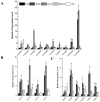Genome-Wide Analysis of DCL, AGO, and RDR Gene Families in Pepper (Capsicum Annuum L.)
- PMID: 29601523
- PMCID: PMC5979589
- DOI: 10.3390/ijms19041038
Genome-Wide Analysis of DCL, AGO, and RDR Gene Families in Pepper (Capsicum Annuum L.)
Abstract
RNA silencing is an evolutionarily conserved mechanism that regulates variety of cellular processes in plants. Argonaute protein (AGO), Dicer-like protein (DCL) and RNA-dependent RNA polymerase (RDR) are critical components of RNA silencing. These efficient and indispensable components of the RNAi pathway have not been identified and characterized in pepper. In this study, we identified 12 CaAGO, 4 CaDCL and 6 CaRDR genes in pepper and compared them with those of Arabidopsis, tobacco, potato and tomato. Detailed phylogenetic analyses revealed that each CaAGO, CaDCL and CaRDR protein family were classified into four clades. The tissue specific expression and respond to abiotic or biotic stress were studied. The real-time quantitative polymerase chain reaction (PCR) results demonstrated that CaAGO2, CaAGO10b, CaDCL2 and CaDCL4 were upregulated with cucumber mosaic virus (CMV), potato virus Y (PVY) and tobacco mosaic virus (TMV) infections, whereas they showed difference expression patterns in response to abiotic stress. In addition, we found that many of the candidate genes were induced by phytohormones and H₂O₂ treatment. Our results provide useful information for further elucidation of gene silencing pathways and RNAi-mediated host immunity in pepper.
Keywords: Argonaute (AGO); Dicer-like (DCL); RNA-dependent RNA polymerase (RDR); pepper.
Conflict of interest statement
The authors declare no conflict of interest.
Figures






Similar articles
-
Genome-Wide Analyses of the NAC Transcription Factor Gene Family in Pepper (Capsicum annuum L.): Chromosome Location, Phylogeny, Structure, Expression Patterns, Cis-Elements in the Promoter, and Interaction Network.Int J Mol Sci. 2018 Mar 29;19(4):1028. doi: 10.3390/ijms19041028. Int J Mol Sci. 2018. PMID: 29596349 Free PMC article.
-
Genome-wide identification of DCL, AGO and RDR gene families and their associated functional regulatory element analyses in sunflower (Helianthus annuus).PLoS One. 2023 Jun 9;18(6):e0286994. doi: 10.1371/journal.pone.0286994. eCollection 2023. PLoS One. 2023. PMID: 37294803 Free PMC article.
-
Transcriptome profiling using Illumina- and SMRT-based RNA-seq of hot pepper for in-depth understanding of genes involved in CMV infection.Gene. 2018 Aug 5;666:123-133. doi: 10.1016/j.gene.2018.05.004. Epub 2018 May 3. Gene. 2018. PMID: 29730427
-
Viromes of 15 Pepper (Capsicum annuum L.) Cultivars.Int J Mol Sci. 2022 Sep 10;23(18):10507. doi: 10.3390/ijms231810507. Int J Mol Sci. 2022. PMID: 36142418 Free PMC article. Review.
-
The SnRK2 family in pepper (Capsicum annuum L.): genome-wide identification and expression analyses during fruit development and under abiotic stress.Genes Genomics. 2020 Oct;42(10):1117-1130. doi: 10.1007/s13258-020-00968-y. Epub 2020 Jul 31. Genes Genomics. 2020. PMID: 32737808 Review.
Cited by
-
Comprehensive In Silico Analysis of RNA Silencing-Related Genes and Their Regulatory Elements in Wheat (Triticum aestivum L.).Biomed Res Int. 2022 Sep 19;2022:4955209. doi: 10.1155/2022/4955209. eCollection 2022. Biomed Res Int. 2022. PMID: 36177060 Free PMC article.
-
Genome-Wide Identification and Characterization of Argonaute, Dicer-like and RNA-Dependent RNA Polymerase Gene Families and Their Expression Analyses in Fragaria spp.Genes (Basel). 2023 Jan 1;14(1):121. doi: 10.3390/genes14010121. Genes (Basel). 2023. PMID: 36672862 Free PMC article.
-
Genome-Wide Identification and Expression Analyses of the Cotton AGO Genes and Their Potential Roles in Fiber Development and Stress Response.Genes (Basel). 2022 Aug 20;13(8):1492. doi: 10.3390/genes13081492. Genes (Basel). 2022. PMID: 36011401 Free PMC article.
-
Atypical DNA methylation, sRNA-size distribution, and female gametogenesis in Utricularia gibba.Sci Rep. 2021 Aug 3;11(1):15725. doi: 10.1038/s41598-021-95054-y. Sci Rep. 2021. PMID: 34344949 Free PMC article.
-
Genome-wide identification of DCL, AGO and RDR gene families and their associated functional regulatory elements analyses in banana (Musa acuminata).PLoS One. 2021 Sep 2;16(9):e0256873. doi: 10.1371/journal.pone.0256873. eCollection 2021. PLoS One. 2021. PMID: 34473743 Free PMC article.
References
MeSH terms
Substances
LinkOut - more resources
Full Text Sources
Other Literature Sources

